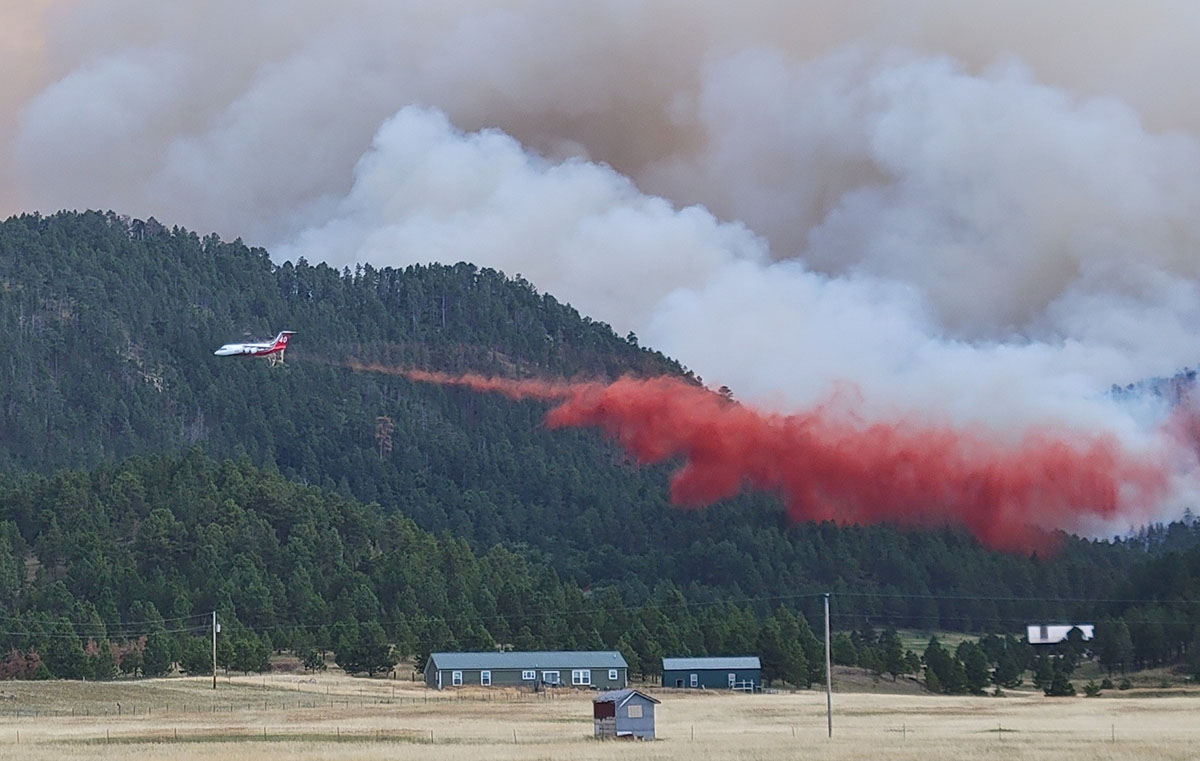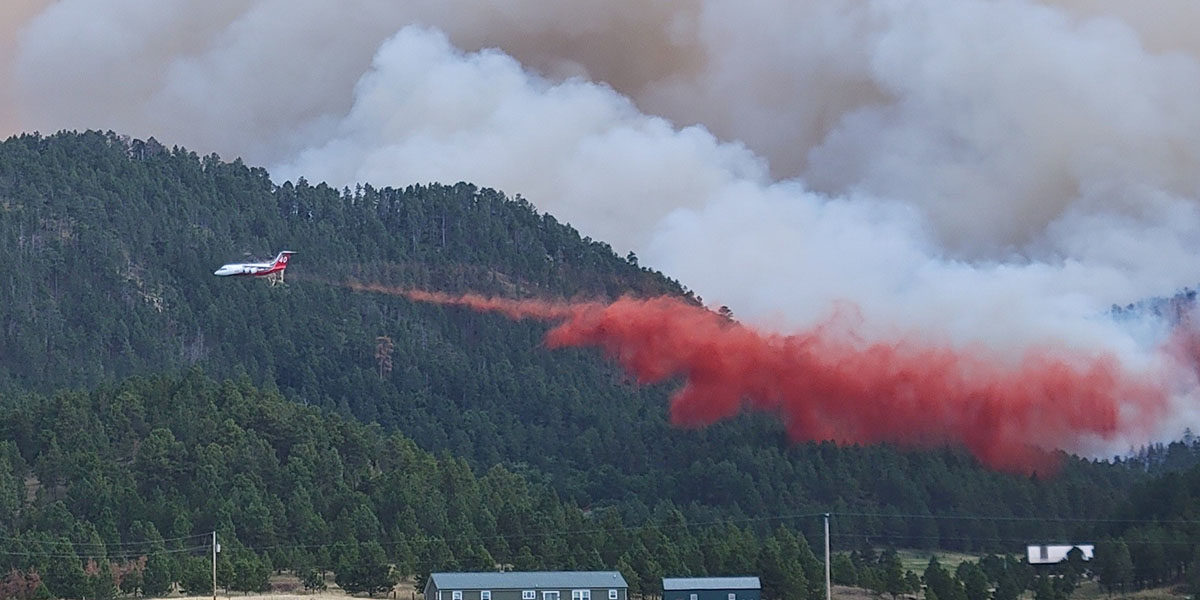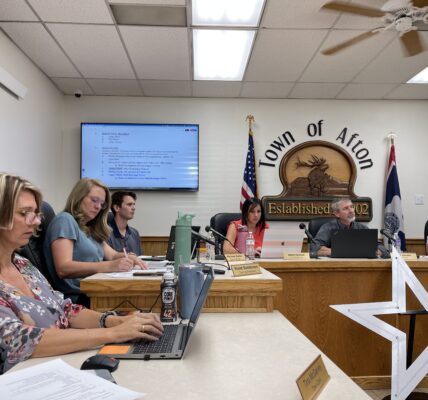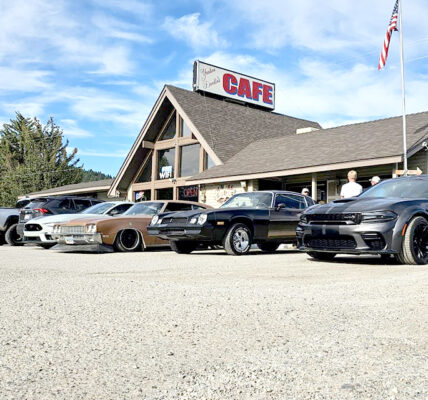
By Sarah Pridgeon
Sundance Times
Via- Wyoming News Exchange
SUNDANCE — A fire burning in steep, rugged terrain on Iron Mountain — seven miles south of Sundance — had grown to 6500 acres by Tuesday afternoon after expanding overnight as high winds caused it to run past the control lines.
At press time, the fire was zero percent contained with no estimate as to when it would be brought under control.
“Exact longevity is hard to tell at this point,” said incident commander Timothy Sherwin on Tuesday morning.
The cause of the Fish Wildfire is under investigation, but the U.S. Forest Service has stated it is believed to have been human-caused on private land.
Fire crews were aiming to set an anchor point Tuesday afternoon, Sherwin said, with the prolonged forecast suggesting more winds would be coming Friday, followed by a cold front.
By Tuesday afternoon, an estimated 250 personnel were at the scene, including two Type 1 and one Type 2 helicopters and a slurry bomber.
After the Fish Wildfire was reported at around 11:30 a.m. on Sunday, the response included federal, state and local firefighters. Resources from Crook County, the U.S. Forest Service and the State of Wyoming Division of Forestry were actively engaged in suppression efforts by Sunday evening, with air attack resources initially including a Type 1 (heavy) helicopter and air tankers.
“It’s just been an all-around, good interagency response to this fire,” said Chris Zoller, fire management officer for the Black Hills northern zone, on Monday afternoon. “We’ve worked really hard with the county to have a good, strong interagency relationship and they reciprocated that back towards us, and it shows in times like this.”
Sherwin later agreed, commenting that “Crook County has done an outstanding job.”
About 20 homes were evacuated on Sunday afternoon along the Highway 585 corridor and in Fish Canyon.
Due to the hot, dry, windy conditions and the steep terrain, the fire had progressed to the east by late Monday afternoon and was threatening the Canyon Springs subdivision. Crews were actively engaged in providing structure protection around residences.
Meanwhile, firefighters worked to build containment lines while air attack resources made retardant drops.
By Tuesday, no structures had been lost to the fire, said Sherwin.
The fire is reported to have made a sudden push south on the east side of the highway on Monday evening, moving fast and hard. At the rate it was traveling, it was initially thought that the fire might cross into Weston County and further evacuations would be needed, but the fire died down as the night progressed.
The fire was relatively calm on Tuesday morning, but slope runs and individual crown torchings were occurring. Crews were anticipating individual spot pick-ups during the afternoon, said Sherwin.
At press time, the fire was most active along the northeastern and southeastern edges.
The fire started relatively slowly on Sunday, but gathered speed quickly.
“It popped up the hill at about ten or 15 acres in probably a couple of hours. Once it reached the top of that hill and was able to roll out and spot over the hill, it got to moving a little better and we were in for a fight,” Zoller said. “It moved extremely well through this country because you’ve got fuels and that topography, which produced pretty good runs.”
The fire is located in an area he refers to as ‘burnable country,’ due to how difficult it is to mitigate fuels on the steep terrain.
“You can’t get crews in there, you can’t get equipment in there, so you’ve got a pretty good fuel load,” he said.
Firefighters realized quickly that they weren’t going to be able to fight the Fish Wildfire head on.
“Initially, when we got here, we went ahead and started doing that scouting, and doing the interior, and getting off the roads, but it just wasn’t working for us,” Zoller said.
Instead, once the sun went down and the fuels on the ground had cooled a little, the plan was to start burning again to start clearing fuel in the fire’s path. Control lines had been set up to encompass about 1200 acres in hopes that the fire could be coaxed toward lower ground.
Down on the grass, Zoller explained, “a firefighter’s got a better chance than up on the steep ground.”
“We would rather fight this fire in the grasses because we can control that a little better. Grasses burn very rapidly at a high intensity, but we can put them out faster,” he said.
On Monday afternoon, a Type 3 team from the State of Wyoming arrived to take over the incident. The level of a fire is determined by looking at complexity, size and the amount of resources needed, as well as the necessary logistics.
“In this situation, there were a couple of things that made us order a Type 3 team. One is logistics: they bring a whole logistics field with them because it’s an organized Type 3 team. That takes the burden off of us,” Zoller said.
The second consideration was the need to free up local resources.
Releasing some of the county and Forest Service firefighters means the local response can be better able to respond to any other fires that may start in this area.
“We’re definitely going to see an increase in fire activity,” Zoller said of the remainder of this summer.
As the season goes on, the terrain loses its moisture almost like a pond drying up, Zoller said. At the center of the Hills, there’s still green, lush grass under the tree canopy, but at the edges the dryness is creeping into the forest.
“Campbell County and western Crook County all turn about this time of year – late July and early August are our traditional fire season, and then it goes into the Hills where we still hold onto our moisture a little better, but you can still see it,” he said. “Even in the southern Black Hills, you can still see that migration of that fire season come up from the south into the main body of the Hills.”
The Black Buttes is not entirely typical to the rest of the Hills this year, however.
“I think we had a hole here for moisture. I think we had a lot of areas that had quite a lot of moisture in this country, but this Black Buttes area is kind of lacking in moisture,” he said.
As the fire danger climbs, Zoller strongly recommends that homeowners consider taking FireWise measures around their property.
“Trimming trees, creating that green space – and if you don’t have green space then maybe some gravel can help it be defensible,” he said.
Zoller also asks that community members pay attention to the county burn ban and what it entails during this more dangerous part of the summer.
An area closure is in place south of Clark Road to Reynolds Road, south to Moskee and west to Wyoming Highway 585. For public and firefighter safety, the public has been asked to stay away from the area until it is safe to return.
WYDOT announced that WY 585 had been closed to the county line at 9:30 p.m. on Monday.
Zoller also asks that those traveling nearby remain aware that their presence has the potential to disrupt firefighting efforts.
“While this incident is ongoing, please be cognizant of moving up and down this highway,” Zoller said. “A lot of people are stopping and looking at all the fancy aircraft and the smoke and that could actually be impeding fire activity or could cause an accident.”
Please also avoid flying drones near the scene of the fire, as this can seriously impact firefighting activities.
“If a drone is flying, we can’t fly,” he said. “All of our aircraft on this fire would be grounded immediately.”






